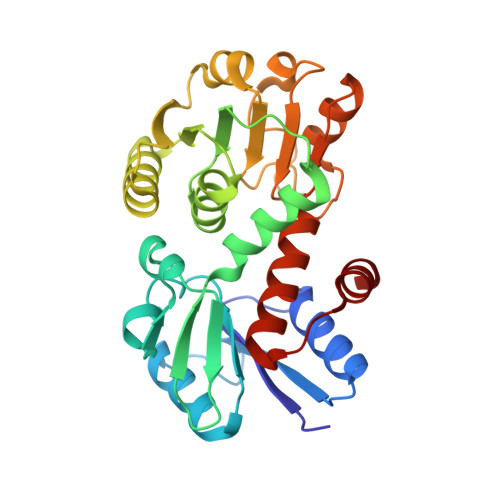Enzyme-substrate complexes of the quinate/shikimate dehydrogenase from Corynebacterium glutamicum enable new insights in substrate and cofactor binding, specificity, and discrimination.
Hoppner, A., Schomburg, D., Niefind, K.(2013) Biol Chem 394: 1505-1516
- PubMed: 23929881
- DOI: https://doi.org/10.1515/hsz-2013-0170
- Primary Citation of Related Structures:
3JYO, 3JYP, 3JYQ - PubMed Abstract:
Quinate dehydrogenase (QDH) catalyzes the reversible oxidation of quinate to 3-dehydroquinate by nicotineamide adenine dinucleotide (NADH) and is involved in the catabolic quinate metabolism required for the degradation of lignin. The enzyme is a member of the family of shikimate/quinate dehydrogenases (SDH/QDH) occurring in bacteria and plants. We characterized the dual-substrate quinate/shikimate dehydrogenase (QSDH) from Corynebacterium glutamicum (CglQSDH) kinetically and revealed a clear substrate preference of CglQSDH for quinate compared with shikimate both at the pH optimum and in a physiological pH range, which is a remarkable contrast to closely related SDH/QDH enzymes. With respect to the cosubstrate, CglQSDH is strictly NAD(H) dependent. These substrate and cosubstrate profiles correlate well with the details of three atomic resolution crystal structures of CglQSDH in different functional states we report here: with bound NAD+ (binary complex) and as ternary complexes with NADH plus either shikimate or quinate. The CglQSDH-NADH-quinate structure is the first complex structure of any member of the SDH/QDH family with quinate. Based on this novel structural information and systematic sequence and structure comparisons with closely related enzymes, we can explain the strict NAD(H) dependency of CglQSDH as well as its discrimination between shikimate and quinate.
















